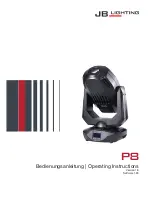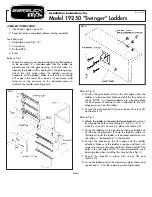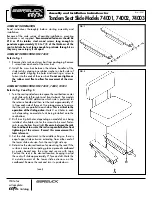
Rev C
061319
MSRD08
D = Dorsal D-Ring Shift and FBH Stretch
E = Safety Factor
F = Sub Total-Minimum Required Fall Clearance
G = Additional Fall Clearance Calculation for Swing Fall – 4' maximum
H = Minimum Required Fall Clearance
Use Figure 3A as a worksheet. The MRFC for this anchorage geometry is calculated as A+B+C+D+E=F.
F is the Sub Total-MRFC. This total does NOT account for swing fall. If a swing fall condition exists, use Chart 2 to determine the amount of swing
fall present. That value is the G variable. G+F=H.
4.1.2 Calculate SRL-LE MRFC Anchorage: 0' Setback From Leading Edge and 5' Below the Dorsal D-ring:
With the anchor installed at zero set back
and below the D-ring, as shown in Figure 3B, there are eight metrics to consider when calculating the MRFC. These eight metrics are labeled A, B,
C, D, E, F, G and H. These metrics are;
A = Free Fall Distance due to Below D-ring Anchorage
B = SRD deceleration distance
C = Additional Deceleration Distance - Note the added deceleration distance for 0' setback.
D = Dorsal D-Ring Shift and FBH Stretch
E = Safety Factor
F = Sub Total- Minimum Required Fall Clearance
G = Additional Fall Clearance Calculation for Swing Fall – 4' maximum
H = Total Required Fall Clearance
Use Figure 3B as a worksheet. The MRFC for this anchorage geometry is calculated as A+B+C+D+E= F.
F is the Sub Total-MRFC. This total does NOT account for swing fall. If a swing fall condition exists, use Chart 1 to determine the amount of swing
fall present. That value is the G variable. G+F=H.
4.1.3 Swing Fall with 5' Setback:
A swing fall condition is created when the user travels laterally from directly in front of or below the anchorage, as
shown by metric C in Figure 4A. For each foot of work zone expansion, the risk of severe injury or death from a swing fall increases. This increased
risk requires additional MRFC distance, up to a maximum of 4' of added clearance.
If the user exceeds maximum lateral travel, the swing force of a fall event would cause the lifeline to swing and abrade on the edge, with increased
risk of damage to or otherwise compromising the lifeline, resulting in serious injury or death to the user. Limit potential swing fall abrasion risk by
limiting lateral travel.
See Chart 1 for instructions on how to determine a safe lateral travel distance.
4.1.4 Swing Fall with 0' Setback:
A swing fall condition with 0' setback is shown by metric C of Figure 4B. For each foot of work zone expansion, the
risk of severe injury or death from a swing fall increases. This increased risk requires additional MRFC distance, up to a maximum of 4' of added
clearance. See Chart 2 for instructions on how to determine a safe lateral travel distance. A swing fall, combined with the user at the maximum
allowable lateral travel, will cause the lifeline to abrade along and across the edge. This may cause severe lifeline or energy absorber damage over a
rough, sharp, or abrasive edge. Limit lateral travel to avoid swing falls.
WARNING
An expanded work zone combined with an SRD attached at or near foot level will have a high risk of serious injury or death.
4.1.5 Angle of Redirection:
The angle of redirection is the angle of the lifeline over an edge during a fall event. Install the SRD so that the angle of
the two parts of the lifeline are at least 90°, or more, but never less, as shown in Figure 5A. The lifeline must never rise up to the edge as it may
bend the lifeline in too small a radius and/or severely abrade, or otherwise compromise, the lifeline.
Do not
work with the leading edge above the anchorage.
4.1.6 Edge Conditions:
Leading Edge conditions vary, and may be composed of steel
I-beams with purlins, steel deck, metal roofing, or poured concrete or cinder block as shown in Figure 5B.
4.1.7 Incorrect Use:
Additional factors to avoid, as shown in Figure 5C;
Do not
allow the lifeline to drape over and edge during normal work as this may abrade, damage, or otherwise compromise the lifeline.
Do not
attach the anchor on one side of an opening and work on the other side, as this creates multiple possible leading edges and potential swing
fall hazards.
Do not
use 3/16" steel cable in leading edge applications. Use only 7/32" cable in leading edge applications.
4.2 Operation of the SRD:
Before each use, inspect the SRD.
4.2.1 Locking Mechanism:
The SRD utilizes an acceleration based locking mechanism. The locking function requires a certain payout rate during a
fall event to function correctly. Certain situations, confined or cramped spaces, shifting footing such as sand, gravel, grain, or a sloped surface may
not allow the lifeline to reach sufficient speed to activate the lock mechanism. A clear path is required to assure positive locking of the SRD.
Ensure
the lock is functioning properly. Pull the lifeline out a short distance and give it a sharp tug. The lifeline must lock. If it fails to lock, remove it from
service immediately.
Ensure the work zone remains within stated parameters. Beware of Leading Edge hazards.
DO NOT
attach an additional shock absorbing lanyard or similar device between the SRD housing and the anchorage.
4.2.2
Fall Arrest Impact Indicator:
The primary fall arrest impact indicator is the load-indicating leg-end connector. The connector will display a red
band if it has been subjected to fall arrest, or equal, forces, as shown in Figure 6. The auxiliary Energy Absorber (EA) installed immediately above
the leg end carabiner is the secondary indicator. If the EA shows any sign of damage, torn or ripped cover, frayed thread, burns or trauma of any
kind, remove the unit from service and tag it as "UNUSABLE".
4.2.3 Lifeline Operational Limit and Reserve Indicators:
The SRD is equipped with two lifeline length indicators as shown in Figure 7; a green
marker to indicate the end of the lifeline's working length, and a red marker, to indicate the reserve cable in the housing has been breached.
When the SRD lifeline is extended to its operational limit, the lifeline will stop paying out. A green marker will be visible, as shown in Figure 7. The
green marker, and a small portion of the lifeline past it, may become visible due to manufacturing variables during normal use, but the user will
know when the operational end is reached. Do not attempt to pull out more lifeline. Extracting additional lifeline will compromise SRD
functionality, and may result in serious injury or death






































